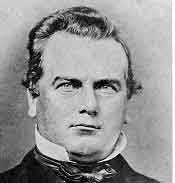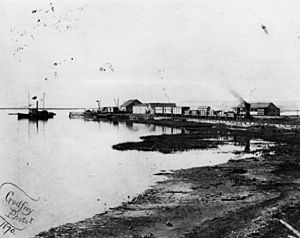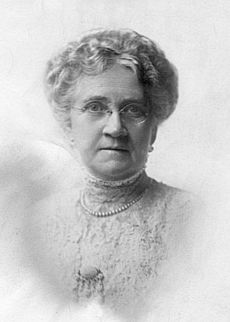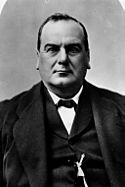Phineas Banning facts for kids
Quick facts for kids
Phineas Banning
|
|
|---|---|

Founder of the Port of Los Angeles
|
|
| Born | August 19, 1830 Wilmington, Delaware, USA
|
| Died | March 8, 1885 (aged 54) |
| Spouse(s) | Rebecca Sanford (1856–1868) (her death) Mary Hollister (1870–1885) (his death) |
Phineas Banning (born August 19, 1830 – died March 8, 1885) was a smart American businessman. He helped start many important projects.
People called him "The Father of the Port of Los Angeles". He helped create the town of Wilmington, California. This town was named after his birthplace. His hard work helped build one of the world's busiest ports.
Phineas Banning ran a business that moved goods. He also started stagecoach lines. These lines connected places like San Pedro to Wilmington. Later, he connected Banning, California (named after him) to Yuma, Arizona.
During the American Civil War, he gave land to the Union Army. They built a fort called the Drum Barracks in Wilmington. He was given the honorary title of brigadier general. He used the title "General" for the rest of his life.
Contents
Early Life and Big Dreams
Banning was born in Wilmington, Delaware. He was the seventh of 11 children. When he was 13, he moved to Philadelphia to work. He worked in his oldest brother's law office.
By his late teens, Banning worked at the dockyards in Philadelphia. At age 20, he decided to travel to Southern California.
California Adventures and New Businesses
Banning arrived in San Pedro, California, in 1851. He had a long journey by land and sea. He crossed the isthmus of Panama to get there.
The 21-year-old was very ambitious. He first worked as a store clerk in San Pedro. Then, he became a stagecoach driver. His route connected San Pedro with Los Angeles, which was a small town back then.
Banning started his own stagecoach and shipping company. By the 1860s, his stagecoaches went to many places. They traveled to Salt Lake City and the Kern River gold fields. They also went to Yuma, Arizona and San Bernardino, California.
Banning wanted to do more than just run stagecoaches. He also worked on expanding the harbor and docks in San Pedro. He made them much more efficient.
In the late 1850s, Banning and other investors bought land near San Pedro. They bought 640 acres for port expansion. This land became the town of Wilmington. It was named after Banning's birthplace in Delaware. His port facility was called Banning's Landing.
Banning used his profits to build a better port. He also created roads, telegraph lines, and other connections to Los Angeles. In 1859, the first big ship anchored in the Los Angeles-Wilmington harbor. By the 1860s, small-scale trade began. Later, the government helped by dredging the harbor. This made it deep enough for bigger ships.
Family Life
In 1856, Banning married Rebecca Sanford. She was the younger sister of his first boss in California. Phineas and Rebecca had eight children. Three of them lived to be adults. Their names were William, Joseph, and Hancock.
Their family life was happy. Phineas was a loving father to his three boys. They grew up near the busy docks in San Pedro. Rebecca Banning died in 1868 during childbirth. Her baby, Vincent, also died.
In 1870, Banning married Mary Hollister. She was from a wealthy family. Her family's name was used for the city of Hollister, California. Phineas and Mary had three children. Two of them lived to adulthood: Mary Hollister Banning and Lucy Tichenor Banning.
Developing Southern California
California During the Civil War
The American Civil War started in 1861. Many people in Los Angeles supported the Southern states. This was a concern for the Union. Phineas Banning was a strong supporter of the Union. He and another politician, Benjamin Davis Wilson, gave land in Wilmington for a military base.
This base was called Drum Barracks. It was the headquarters for the Union army in California and Arizona. This brought Union troops to Wilmington, which helped Banning's businesses.
In 1863, Banning and his first wife, Rebecca, were almost killed. The boiler exploded on one of his ships, the SS Ada Hancock. After the Civil War ended in 1865, Drum Barracks closed. But the port continued to grow.
The U.S. government gave Banning an honorary title. He became a Brigadier General of the California First Brigade. This title was just for honor, not for military service. But Banning always wanted to be called "General Banning."
Railroads and Port Growth
Between 1868 and 1869, Banning built Southern California's first railroad. It was called the Los Angeles & San Pedro Railroad. He later sold it to the Southern Pacific Railroad in 1873.
Banning was very busy in the 1870s. As a California state senator, he pushed for better transportation. He wanted more connections to Los Angeles and his growing port. He helped create a plan for a small railroad. This railroad linked Wilmington/San Pedro with Los Angeles. It cut travel time in half.
However, the Southern Pacific Railroad was building tracks across the country. They wanted to connect Southern California to their national lines. They demanded a lot from Los Angeles. They wanted prime land, a lot of money, and Banning's small railroad. If Los Angeles didn't agree, the railroad would bypass the city. The city agreed, and Banning gave up his railroad.
The first breakwater was built for the new port in 1873. Banning also started working for the Southern Pacific as a railroad agent.
Final Years and Lasting Impact
By 1880, Banning had moved to Wilmington. He managed several smaller businesses. He was not in good health for two years before he died. He had liver and kidney problems. An accident in San Francisco made his health worse. He was hit by an express wagon.
Phineas Banning died at age 54 in San Francisco. He is buried in the Angelus-Rosedale Cemetery in Los Angeles.
Banning's dreams came true after his death. The federal government approved the Port of Los Angeles in the early 1900s. A full breakwater was finished in 1914. This created one of the world's busiest harbors.
Banning's main home was built in Wilmington in 1864. Today, it is a museum. You can visit it to learn about the Victorian era in California.




